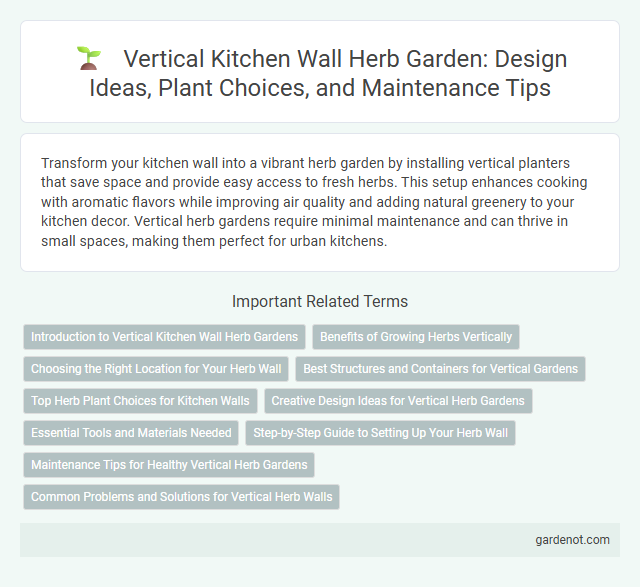Transform your kitchen wall into a vibrant herb garden by installing vertical planters that save space and provide easy access to fresh herbs. This setup enhances cooking with aromatic flavors while improving air quality and adding natural greenery to your kitchen decor. Vertical herb gardens require minimal maintenance and can thrive in small spaces, making them perfect for urban kitchens.
Introduction to Vertical Kitchen Wall Herb Gardens
Vertical kitchen wall herb gardens maximize limited space by growing fresh herbs upward on walls, combining functionality with aesthetic appeal. These gardens use pockets, planters, or racks to cultivate basil, mint, rosemary, and thyme within easy reach for cooking, ensuring constant access to fresh ingredients. Integrating a vertical herb garden improves indoor air quality and supports sustainable living by reducing the need for store-bought herbs.
Benefits of Growing Herbs Vertically
Growing herbs vertically on a kitchen wall maximizes limited space, allowing easy access to fresh ingredients while enhancing air quality indoors. Vertical herb gardens improve plant health by providing optimal light exposure and better air circulation, reducing pest issues and promoting robust growth. This setup also adds aesthetic value to the kitchen, creating a lively green focal point that encourages sustainable, homegrown cooking.
Choosing the Right Location for Your Herb Wall
Selecting the ideal spot for a kitchen wall herb garden involves prioritizing access to natural light, as most herbs require at least 4-6 hours of direct sunlight daily to thrive. Consider placing the herb wall near a south-facing window or an area with consistent, indirect light to ensure optimal growth and flavor. Proper ventilation and easy access for watering and harvesting enhance plant health and kitchen convenience.
Best Structures and Containers for Vertical Gardens
Vertical kitchen wall herb gardens thrive using materials such as wooden pallets, metal grids, and modular pocket planters, each offering durability and space efficiency. Containers like fabric pockets, terra cotta pots, and recycled plastic bottles optimize root aeration and moisture retention. Selecting lightweight, UV-resistant structures enhances longevity and ease of maintenance in indoor or outdoor kitchen environments.
Top Herb Plant Choices for Kitchen Walls
Basil, parsley, and thyme are top herb plant choices for kitchen wall gardens due to their compact growth and frequent culinary use. These herbs thrive in vertical garden setups, requiring minimal space while offering fresh flavor for cooking. Incorporating mint and rosemary also enhances kitchen wall gardens with aromatic and versatile options.
Creative Design Ideas for Vertical Herb Gardens
Maximize kitchen space with vertical herb gardens using modular wall planters that combine functionality and style. Incorporate reclaimed wood shelves or magnetic containers to create an eco-friendly, customizable herb display that enhances kitchen aesthetics. Integrate smart irrigation systems for effortless maintenance, ensuring fresh herbs are always within reach for cooking.
Essential Tools and Materials Needed
Creating a kitchen wall herb garden requires essential tools such as mounting brackets, waterproof planters, and a reliable irrigation system to ensure proper water drainage and plant health. High-quality potting soil enriched with organic compost supports optimal herb growth while stainless steel or plastic containers prevent rust and mold buildup. A drip watering kit or self-watering system enhances convenience by delivering consistent moisture, crucial for maintaining vibrant, aromatic herbs like basil, rosemary, and thyme.
Step-by-Step Guide to Setting Up Your Herb Wall
Create a thriving kitchen wall herb garden by first selecting a suitable vertical planter that fits your available wall space and provides adequate drainage. Mount the planter securely and fill it with high-quality potting mix enriched with organic matter to support healthy herb growth. Choose a variety of culinary herbs such as basil, thyme, and parsley, then plant them carefully, ensuring they receive sufficient light and regular watering to thrive year-round.
Maintenance Tips for Healthy Vertical Herb Gardens
Proper watering techniques, such as using drip irrigation or self-watering systems, ensure consistent moisture levels crucial for kitchen wall herb gardens. Regular pruning and harvesting promote healthy growth and prevent overcrowding, enhancing air circulation around the herbs. Monitoring for pests and diseases, combined with periodic fertilization using organic compost or balanced liquid fertilizers, sustains nutrient-rich soil and vibrant vertical herb gardens.
Common Problems and Solutions for Vertical Herb Walls
Common problems with kitchen wall herb gardens include inadequate sunlight, poor drainage, and pest infestations. Solutions involve installing grow lights to ensure proper illumination, using self-watering vertical planters with good drainage systems, and applying organic pest repellents to protect plant health. Regular pruning and choosing hardy herb varieties also enhance the longevity and productivity of vertical herb walls.
Kitchen wall herb garden Infographic

 gardenot.com
gardenot.com